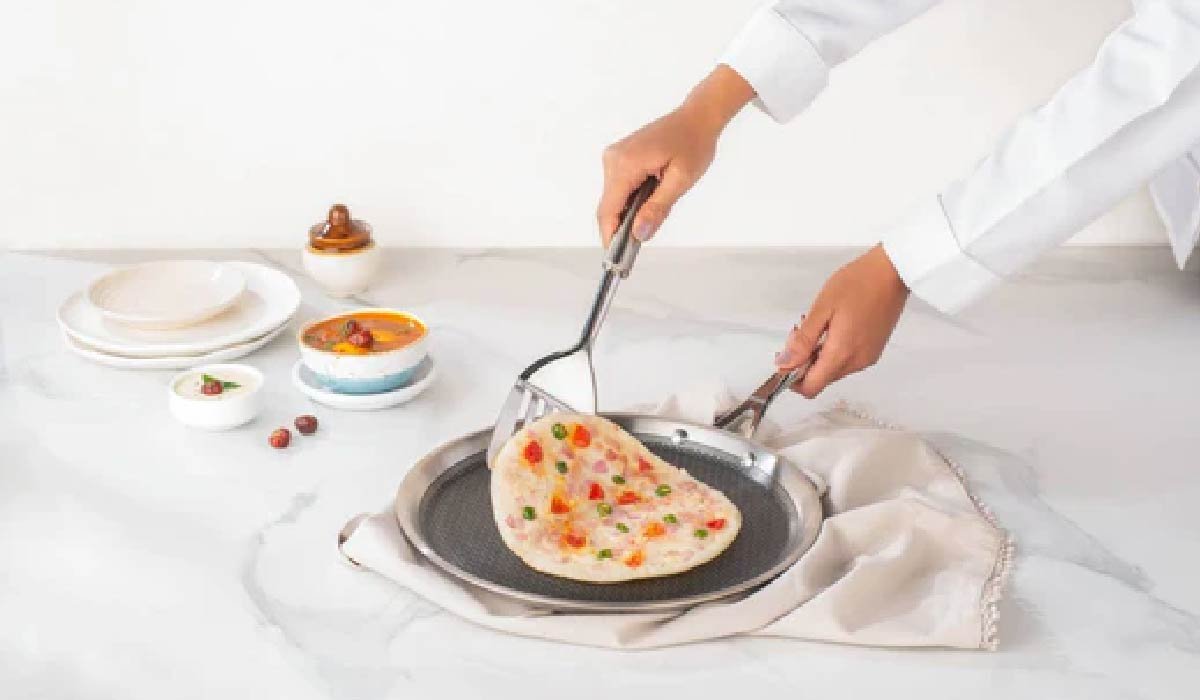Food
Top 5 Features To Look For When Buying A Dosa Tawa

Dosas, the golden and crispy South Indian treat, need special cookware to achieve perfection. A good dosa tawa is the key to uniform cooking, non-stickiness, and a perfectly enhanced taste and texture of your dosas. But with the multitude of dosa tawas in the market today, getting the correct one can be daunting.
If you are going to purchase a dosa tawa, knowing the vital features will enable you to make a well-informed choice. In the following, we elaborate extensively on the most crucial points you should consider to make sure that your dosa tawa serves your cooking purposes and lasts for years.
1. Size & Thickness: Choosing the Right Dimensions
The size of your dosa tawa plays a significant role in your cooking experience. The standard size of a dosa tawa ranges from 10 inches to 14 inches in diameter, and selecting the right size depends on your cooking preferences.
- Smaller tawas (10-11 inches): Ideal for small households or for making mini dosas, pancakes, or chapatis.
- Medium-sized tawas (12 inches): Suitable for most home kitchens, allowing for well-sized dosas without taking up too much stove space.
- Larger tawas (13-14 inches)—best for those who love making large, restaurant-style dosas that are extra thin and crispy.
Why Thickness Matters
A dosa tawa that is too thin will cause uneven cooking, leading to burnt or undercooked spots. Ideally, the tawa should be thick enough to distribute heat evenly but not too thick that it takes too long to heat up. A thickness of 3-5mm is optimal as it allows for better heat retention and prevents warping over time.
2. Flat or Slightly Concave Surface
The surface shape of your dosa tawa affects how the dosa batter spreads and cooks. Most dosa tawas come with either a completely flat or a slightly concave surface.
- Flat Surface: This is the best option for making dosas because it ensures uniform heat distribution. A flat tawa allows the batter to spread evenly, giving you perfectly crisp dosas.
- Slightly Concave Surface: Some dosa tawas have a slightly concave center, which helps in containing the batter in the middle. However, if the concavity is too deep, the batter might pool, leading to uneven cooking.
For dosa-making, a flat tawa is generally preferred as it ensures a thin, evenly spread dosa with consistent cooking throughout.
3. Heat Distribution & Retention: The Key to Even Cooking
One of the most critical aspects of a dosa tawa is its ability to distribute and retain heat. If the tawa does not distribute heat evenly, you may end up with dosas that are crispy on one side and undercooked on the other.
A good dosa tawa should:
- Heat up quickly to reduce waiting time.
- Retain heat well so that you can cook multiple dosas without reheating the tawa repeatedly.
- Distribute heat evenly across the surface to prevent hot spots.
A well-balanced dosa tawa will ensure that your dosas cook uniformly, giving them the perfect texture and taste.
4. Compatibility with Different Stovetops: Gas, Induction, and Electric
Not all dosa tawas are compatible with every type of stovetop. Before purchasing, you need to ensure that your chosen tawa works with your existing kitchen setup.
- Gas Stovetop Compatibility: Traditional dosa tawas are designed for gas stoves, which provide direct heat and allow for better control over cooking temperatures.
- Induction Compatibility: If you use an induction cooktop, make sure the tawa has a flat and induction-compatible base. Some traditional tawas, especially those with uneven surfaces, may not work well with induction cooktops.
- Electric Stovetop Compatibility: If you have an electric stove, choose a tawa with a flat base to ensure maximum heat transfer and efficiency.
Before purchasing, check the product specifications to confirm whether it is compatible with your type of stove.
5. Weight of the Tawa: Finding the Right Balance
The weight of a dosa tawa is another important factor to consider. While a heavier tawa retains heat well and provides better stability, it can also be cumbersome to handle.
- Lightweight Tawas: These heat up quickly and are easy to handle but may not retain heat effectively.
- Heavyweight Tawas: These retain heat well, ensuring evenly cooked dosas, but they can be difficult to lift and maneuver.
A balanced tawa—one that is not too heavy but has enough weight for stability—is ideal. It should sit firmly on the stovetop without wobbling while remaining manageable for daily use.
Final Thoughts
Selecting an appropriate dosa tawa can make a huge difference to your cooking process. Paying attention to size, thickness, heat conduction, surface quality, stovetop type, handle feel, weight, and durability will ensure that you choose a tawa that will assist you in preparing tasty, restaurant-quality dosas from home.
A good-quality dosa tawa will see to it that your dosas turn out perfectly cooked, crispy, and with the perfect taste. With proper features, you get to enjoy the ideal dosa-making experience for many years.
-

 Celebrity1 year ago
Celebrity1 year agoWho Is Jennifer Rauchet?: All You Need To Know About Pete Hegseth’s Wife
-

 Celebrity1 year ago
Celebrity1 year agoWho Is Mindy Jennings?: All You Need To Know About Ken Jennings Wife
-

 Celebrity1 year ago
Celebrity1 year agoWho Is Enrica Cenzatti?: The Untold Story of Andrea Bocelli’s Ex-Wife
-

 Celebrity1 year ago
Celebrity1 year agoWho Is Klarissa Munz: The Untold Story of Freddie Highmore’s Wife
















